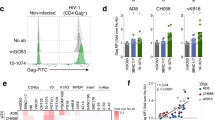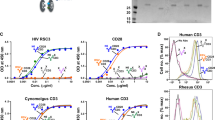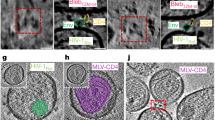Abstract
The CD4 (T4) molecule is expressed on a subset of T lymphocytes involved in class II MHC recognition1,2, and is probably the physiological receptor for one or more monomorphic regions of class II MHC (refs 1–3). CD4 also functions as a receptor for the human immunodeficiency virus (HIV) exterior envelope glycoprotein (gp120) (refs 4–9), being essential for virus entry into the host cell and for membrane fusion, which contributes to cell-to-cell transmission of the virus and to its cytopathic effects10,11. We have used a baculovirus expression system to generate mg quantities of a hydrophilic extracellular segment of CD4. Concentrations of soluble CD4 in the nanomolar range, like certain anti-CD4 monoclonal antibodies, inhibit syncytium formation and HIV infection by binding gp120-expressing cells. Perhaps more importantly, class II specific T-cell interactions are uninhibited by soluble CD4 protein, whereas they are virtually abrogated by equivalent amounts of anti-T4 antibody. This may reflect substantial differences in CD4 affinity for gp120 and class II MHC.
This is a preview of subscription content, access via your institution
Access options
Subscribe to this journal
Receive 51 print issues and online access
$199.00 per year
only $3.90 per issue
Buy this article
- Purchase on Springer Link
- Instant access to full article PDF
Prices may be subject to local taxes which are calculated during checkout
Similar content being viewed by others
References
Meuer, S., Schlossman, S. F. & Reinherz, E. L. Proc. natn. Acad. Sci. U.S.A. 79, 4395–4399 (1982).
Biddison, W., Rao, P., Thalle, M., Goldstein, G. & Shaw, S. J. exp. Med. 156, 1065–1076 (1982).
Gay, D. et al. Nature 328, 626–629 (1987).
Klatzmann, D. et al. Science 225, 59–63 (1984).
Dagleish, A. et al. Nature 312, 763–766 (1984).
Sattentau, Q., Dalgleish, A., Weiss, R. & Beverley, P. C. L. Science 234, 1120–1123 (1986).
McDougal, J. S. et al. J. Immun. 137, 2937–2944 (1986).
McDougal, J. S. et al. Science 231, 382–385 (1986).
Maddon, P. et al. Cell 47, 333–348 (1986).
Sodroski, J., Goh, W. C., Rosen, C., Campbell, K. & Haseltine, W. A. Nature 322, 470–474 (1986).
Lifson, J. et al. Nature 323, 725–728 (1986).
Maddon, P. et al. Cell 42, 93–104 (1985).
Smith, G. et al. Proc. natn. Acad. Sci. U.S.A. 82, 8404–8408 (1985).
Clark, S., Jefferies, W., Barclay, A. N., Gagnon, J. & Williams, A. Proc. natn. Acad. Sci. U.S.A. 84, 1649–1653 (1987).
Matsudaira, P. J. biol. Chem. 262, 10035–10038 (1987).
Classon, B. et al. Immunogenetics 23, 129–132 (1986).
Meuer, S. C. et al. Science 222, 1239–1242 (1983).
Acuto, O., Hussey, R. E. & Reinherz, E. L. J. exp. Med. 162, 1387–1392 (1985).
Krensky, A., Robbins, E., Springer, T. A. & Burakoff, S. J. Immun. 132, 2180–2184 (1984).
Biggin, M., Gibson, T. & Hong, G. Proc. natn. Acad. Sci. U.S.A. 80, 3963–3965 (1983).
Kowalski, M. et al. Science 237, 1351–1355 (1987).
Author information
Authors and Affiliations
Rights and permissions
About this article
Cite this article
Hussey, R., Richardson, N., Kowalski, M. et al. A soluble CD4 protein selectively inhibits HIV replication and syncytium formation . Nature 331, 78–81 (1988). https://doi.org/10.1038/331078a0
Received:
Accepted:
Issue Date:
DOI: https://doi.org/10.1038/331078a0
This article is cited by
-
AAV-expressed eCD4-Ig provides durable protection from multiple SHIV challenges
Nature (2015)
-
Therapeutic Potential of Aptamer-siRNA Conjugates for Treatment of HIV-1
BioDrugs (2012)
-
Current progress in the development of RNAi-based therapeutics for HIV-1
Gene Therapy (2011)
-
Novel antiviral agents targeting HIV entry and transmission
Virologica Sinica (2007)
Comments
By submitting a comment you agree to abide by our Terms and Community Guidelines. If you find something abusive or that does not comply with our terms or guidelines please flag it as inappropriate.



